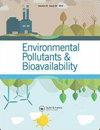离子电荷密度和溶解度在受污染淡水天然生物膜基质对重金属的生物吸附中的作用——以Mg(II)、Cr(VI)和Cu(II)为例
IF 3.2
4区 环境科学与生态学
Q2 BIOCHEMISTRY & MOLECULAR BIOLOGY
Environmental Pollutants and Bioavailability
Pub Date : 2023-06-06
DOI:10.1080/26395940.2023.2220571
引用次数: 0
摘要
本文章由计算机程序翻译,如有差异,请以英文原文为准。
The role of ion charge density and solubility in the biosorption of heavy metals by natural biofilm matrix of polluted freshwater: the cases of Mg(II), Cr(VI), and Cu(II)
ABSTRACT One major cause of aquatic pollution is the accumulation of heavy metal ions. This review is aimed to examine the application of natural biofilm as biosorbent for Mg(II), Cr(VI), and Cu(II), as an eco-friendly, economical, and efficient remediation strategy. Biofilm matrices were collected from different freshwater ecosystems to observe their biosorption properties. The compared EPM values of the different biofilms showed a universal trend. Additionally, the adsorption kinetics of all three ions occurred within 1 minute. The amount of adsorbed Mg(II) was higher than Cu(II), owing to the larger charge density of Mg(II). Interestingly, the b values revealed that Mg(II) was desorbed the quickest among the three ions, which is likely to be influenced by its highest solubility. Thus, both charge density and solubility determined the ions’ biosorption characteristics. Therefore, physicochemical properties of heavy metal pollutants should be understood to achieve an effective bioremediation by natural biofilm.
求助全文
通过发布文献求助,成功后即可免费获取论文全文。
去求助
来源期刊

Environmental Pollutants and Bioavailability
Chemical Engineering-Chemical Health and Safety
CiteScore
4.30
自引率
3.00%
发文量
47
审稿时长
13 weeks
期刊介绍:
Environmental Pollutants & Bioavailability is a peer-reviewed open access forum for insights on the chemical aspects of pollutants in the environment and biota, and their impacts on the uptake of the substances by living organisms.
Topics include the occurrence, distribution, transport, transformation, transfer, fate, and effects of environmental pollutants, as well as their impact on living organisms. Substances of interests include heavy metals, persistent organic pollutants, and emerging contaminants, such as engineered nanomaterials, as well as pharmaceuticals and personal-care products as pollutants.
 求助内容:
求助内容: 应助结果提醒方式:
应助结果提醒方式:


